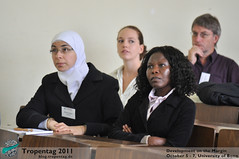mixed cropping
The Seeds of the Future
Tue, 10/11/2011 - 09:56 — De-Registered User
The thematic session on Crop Biotic Stresses on Friday 7 October, 2011 touched upon various research into crop production and crop management methods. While the results were also unique, the discussions at Tropentag focused their interest on the improvement of methodologies.
The impacts of crop management.
The session looked at the effects of Chlorpyrifos in Costa Rica and how they are having a negative impact on the children in the area. The exposure came from the use of Chlorpyrifos-bags used in banana and plantain Plantations. We were also introduced to the research through a microarray analysis of gene expression induced in tomato leaves. The genes were compared between treated/untreated/diseased/healthy tomato plants and observed for activation of plant resistance. Interestingly enough, someone in the crowd commented on the research and arrived at opposite results having done the same research. The debate was left up in the air… to be continued during the following coffee break.
 Fellow presenters listening to their colleague's presentation.
Africa stricken with Striga!
Fellow presenters listening to their colleague's presentation.
Africa stricken with Striga!
 Fellow presenters listening to their colleague's presentation.
Africa stricken with Striga!
Fellow presenters listening to their colleague's presentation.
Africa stricken with Striga!
Oral Presentations III: Mixed Cropping, Agroforestry, and Biofuels
Thu, 09/16/2010 - 11:33 — De-Registered User
This is a sample of some of the great mixed cropping, agroforestry and biofuels oral presentations at Tropentag
Strategies to Use Biofuel Value Chain Potential in Sub-saharan Africa to Respond to Global Change Enhancing Low-productivity Farming in Tanzania and Linking to SMEs – Stefan Sieber
Some of the most significant global drivers stem from energy demands. This study examined new strategies to improve value chains and biofuel potential in order to provide communities in Sub-Saharan Africa with multiple energy services. The study took place in Tanzania, however global applications of the findings was one of the overall objectives.
One way to improve energy demands in developing countries is though linking small scale farmers with small- to medium-scale enterprises. This research project worked with stakeholders in order to develop feasible strategies to maximize profit.
The output from this collaborative effort was the development of global scenarios (applications in other countries), biomass production, consumption patterns, as well as a participatory biomass value chain. The objective of the research was to conduct a sustainability impact analysis and an information system for policy/decision support.




